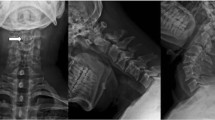Abstract
We report a patient with craniovertebral anomaly leading to cervical cord compression who presented with disabling postural hypotension. A 60-year-old electrician presented with progressive weakness of the upper and lower limbs, which had started 7 years previously. He had had difficulty in holding urine for the previous year and had blacked out on standing for the past 3 months. He had upper limb wasting and lower limb spasticity, with impaired joint position sense. Autonomic dysfunctions included postural hypotension, absence of sinus arrhythmia, impaired Valsalva ratio, and lack of increase in blood pressure on cold immersion and isometric contraction. Cervical spine radiograph and magnetic resonance imaging revealed atlantoaxial dislocation, Klippel-Feil syndrome and osteophytes, resulting in cord compression at C2−C4. Partial and selective damage to the descending autonomic fibres may be responsible for postural hypotension in this patients.
Similar content being viewed by others
References
Mathias CJ, Frankel HL. Clinical manifestation of malfunctioning sympathetic mechanism in tetraplegia.J Autonom Nervous System 1993;7: 303–312.
Aminoff MJ, Wilcox CS. Autonomic dysfunction in syringomyelia.Postgrad Med J 1972;48: 113–115.
Kalita J, Misra UK. Postural hypotension in a patient with acute myelitis.Postgrad Med J 1996;72: 180–182.
Misra UK, Kalita J. Transverse myelitis: neurophysiological and MRI correlation.Paraplegia 1994;32: 593–596.
Misra UK, Kalita J, Pandey R. Primary amyloid neuropathy: a case report.Neurology India 1994;42: 32–33.
Wadia NH. Cogenital atlantoaxial dislocation and its manifestations due to spinal cord compression. In: Spillane JD, ed.Tropical Neurology. London: Oxford University Press, 1973; 99–107.
Zigler MG. Autonomic nervous system in the diseases of spinal cord. In: Davidoff RA, ed.Handbook of the Spinal Cord, vols IV and V. New York: Marcell Dekker, 1987; 299–317.
Mathias CJ. Orthostatic hypotension: causes, mechanisms and influencing factors.Neurology 1995;45(S5): S6–11.
Shy G, Drager G. A neurologic syndrome associated with orthostatic hypotension.Arch Neurol 1960;2: 511–527.
Frankel HL, Mathias CJ. Cardiovascular aspects of autonomic dysreflexia since Guttmann and Witteridge (1947).Paraplegia 1979;17: 46–51.
Haerer AF.Dejong's the Neurologic Examination, 5th edn. New York: JB Lippin Cott, 1992; 506.
Author information
Authors and Affiliations
Corresponding author
Rights and permissions
About this article
Cite this article
Misra, U.K., Kalita, J. & Kapoor, R. Postural hypotension in a patient with cervical myelopathy due to cranio-vertebral anomaly. Clinical Autonomic Research 7, 223–226 (1997). https://doi.org/10.1007/BF02267745
Received:
Accepted:
Issue Date:
DOI: https://doi.org/10.1007/BF02267745




